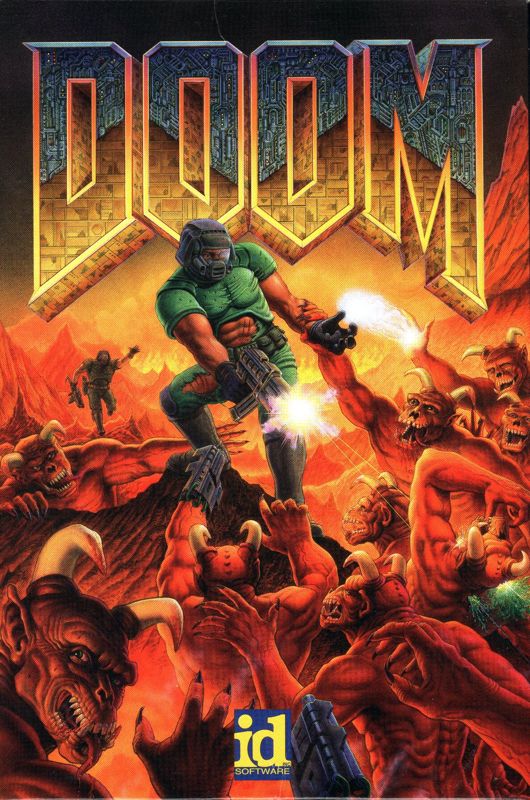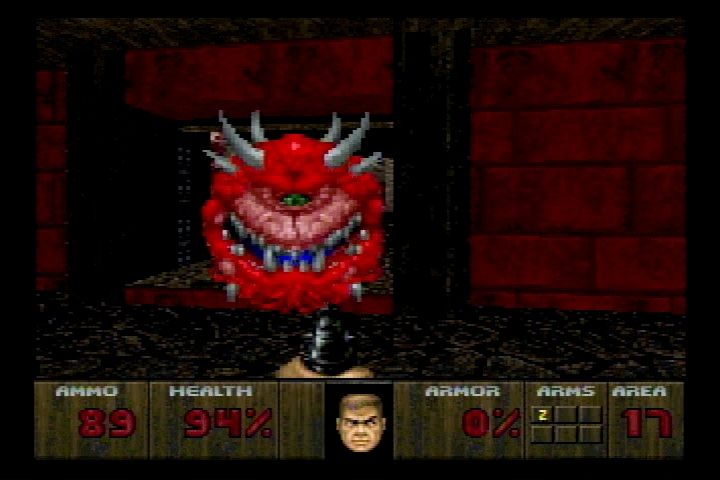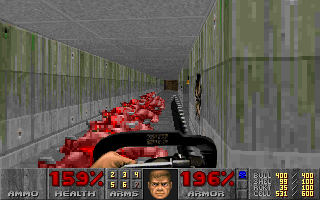Retro Replay Review
Gameplay
Doom’s gameplay is a relentless, fast-paced sprint through corridors, compounds, and hellish landscapes, driven by a simple yet intoxicating premise: you are the lone surviving space marine, armed to the teeth, against an onslaught of demonic invaders. From the moment you touch down on the UAC’s Phobos base, every level becomes a high-stakes gauntlet where your primary objective is to reach the exit—by any means necessary. Health pickups, armor shards, and ammo caches litter the environment, forcing you to balance risk and reward as you decide whether to explore side rooms or push forward.
(HEY YOU!! We hope you enjoy! We try not to run ads. So basically, this is a very expensive hobby running this site. Please consider joining us for updates, forums, and more. Network w/ us to make some cash or friends while retro gaming, and you can win some free retro games for posting. Okay, carry on 👍)
The game’s arsenal is both deep and balanced. You start with the classic pistol and fists, progress through the shotgun and chaingun, and eventually unlock the rocket launcher, plasma rifle, chainsaw, and the legendary BFG9000. Each weapon has distinct advantages and drawbacks—shotguns excel at short-range devastation but falter at a distance, while rockets deliver massive damage with the ever-present risk of self-destruction in tight spaces. Resource management becomes a core strategic element, as you hunt shells, rockets, and energy cells to keep your firepower at its peak.
Level design in Doom is a standout feature that elevates the gameplay from simple corridor crawling to full-blown tactical engagements. The id Tech 1 engine introduces varied heights—stairs, lifts, crushing ceilings—and dynamic lighting, which can plunge you into near-total darkness until you find a light amplification visor. Keycards and skull keys gate progress, making backtracking and exploration essential. The built-in automap reveals the layout but only as you discover it, rewarding careful observation and punishing reckless dashes through unknown territory. Secret rooms and hidden power-ups add an extra layer of challenge and replayability.
Graphics
Although Doom uses 2D sprites for enemies and items, the illusion of 3D is remarkably convincing for its era. Walls can meet at any angle, outdoor areas break up the claustrophobia of indoor mapping, and texture variety—from cold industrial panels on Phobos to blood-stained walls in Inferno—creates a cohesive visual progression. Lighting effects, including flickering bulbs and pitch-black rooms illuminated only by your flashlight, heighten tension and atmosphere.
The devilish design flourishes as you advance: pentagrams etched into floors, grotesque demon portraits, and hanging corpses drip with foreboding detail. Pools of radioactive waste hiss and sizzle, forcing you to navigate carefully or risk a slow, agonizing demise. Environmental hazards such as crushing ceilings or surprise ambushes behind faux walls show that Doom’s graphics aren’t just for show—they directly influence gameplay by keeping you on edge.
Performance remains smooth even on modest hardware of the 1990s, delivering a stable frame rate that keeps the action fluid. Modern source ports and community-made high-resolution texture packs have since revitalized the visuals, but the original aesthetic still holds up thanks to id Software’s strong art direction. Even on console ports like the SNES or 3DO, the core look and feel persist, though some graphical details and lighting nuances are understandably pared back.
Story
The storyline in Doom is lean and to the point: the Union Aerospace Corporation’s teleportation experiments on Phobos and Deimos have torn open a gateway to Hell, unleashing an army of nightmarish demons. Deimos vanishes entirely, while Phobos is overrun. Your squad is quickly slaughtered, leaving you as the sole marine to battle the forces of darkness. There’s little exposition beyond this, but the sparse setup perfectly complements the breakneck action.
Progression through the three episodes—“Knee-Deep in the Dead” on Phobos, “The Shores of Hell” on Deimos, and the final “Inferno” in Hell itself—creates a palpable narrative arc. Each episode ramps up the threats and visuals, from military installations to lava-filled halls and infernal citadels. Keycards, switches, and demon-spattered terminals provide environmental storytelling, hinting at the UAC’s hubris and the horrific consequences of their experiments.
While Doom’s plot doesn’t delve into character development or complex lore, the atmosphere does most of the storytelling for you. The oppressive soundtrack, sudden demon line-of-sight, and claustrophobic corridors all build tension more effectively than pages of dialogue ever could. The minimalist approach leaves room for player interpretation and has inspired countless mods and expansions that flesh out the universe even further.
Overall Experience
Doom remains a benchmark in first-person shooter design, offering an immediate, visceral thrill that keeps players coming back decades later. The core loop of exploration, strategic firepower management, and high-adrenaline combat never grows stale, thanks in part to the wealth of secret areas and multiple difficulty levels. The shareware release of the first episode made the game accessible to a broad audience, while the full retail version delivers two more episodes packed with inventive level design and boss encounters.
Multiplayer modes—cooperative play through the single-player campaign and the competitive Deathmatch—pioneered networked FPS gaming. While some console ports omit these features, the PC version’s LAN and dial-up support laid the groundwork for future online shooters. Communities have since created hundreds of custom WADs, ensuring that Doom’s gameplay remains fresh and varied.
Ultimately, Doom’s enduring appeal lies in its raw, unrelenting action and masterful level design. It strips away extraneous mechanics, focusing on pure combat satisfaction and environmental immersion. Whether you’re a retro enthusiast or a newcomer curious about gaming history, Doom delivers a timeless experience that defined a genre and continues to influence game design to this day.
 Retro Replay Retro Replay gaming reviews, news, emulation, geek stuff and more!
Retro Replay Retro Replay gaming reviews, news, emulation, geek stuff and more!









Reviews
There are no reviews yet.